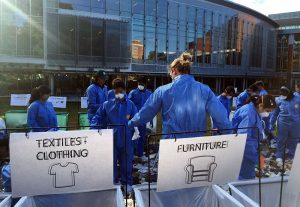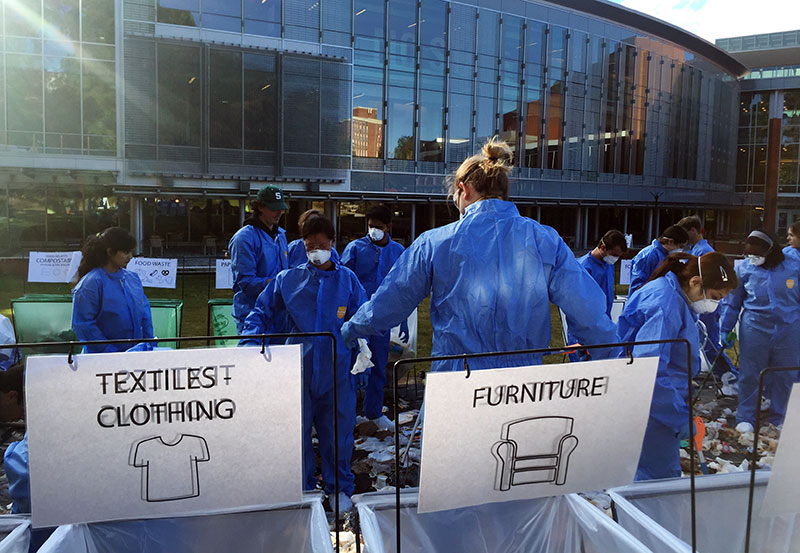
NC State students Madeline Newton and Carly Abney culminated their college experience with a sustainability project of Talley Student Union-sized proportions.
In the last class session of their undergraduate career, these Sustainable Materials and Technology majors were among 30 students who presented the results of a Fall 2016 course that focused on the sustainability of one of the university’s largest and most-visited buildings.
Called LEED Lab, the course is hosted by the School of Architecture in the College of Design. The students worked toward one goal: determining whether Talley Student Union could achieve national certification for sustainable maintenance and operations.
“In our major, we learn about a lot of sustainability issues and general solutions,” Newton said. “This class is a way to dive in and learn how to solve some of those problems. It’s tying together our whole college experience.”
This is the third year NC State offered LEED Lab, which focuses on the popular Leadership in Energy and Environmental Design (LEED) rating system administered by the U.S. Green Building Council.
One of the course’s hallmarks is its interdisciplinary approach that this year brought together engineering, design and natural resources students. Getting this type of project-based, interdisciplinary experience while in school is rare, according to student Jeromy Clements, who is wrapping up a master’s degree in Architecture.
“There are things you’d never think of that other people [from different professional backgrounds] do,” he said.
Talley’s design and construction earned LEED Silver certification in 2015, and a second certification in the LEED Operations and Maintenance category would acknowledge the building’s ongoing sustainability efforts.
“Many of these students are future designers. This class helps them learn what happens after a building is built and ask, ‘How can knowledge of operations and maintenance best practices inform my future designs?’” said course co-instructor Liz Bowen, who is a program coordinator in the University Sustainability Office.
To achieve operations and maintenance certification, a building earns points for efforts in areas such as transportation, water, energy, materials, waste reduction and indoor environmental quality. The students’ evaluation included conducting transportation surveys with occupants and visitors, coordinating an energy audit, reviewing lighting efficiency and refrigerant use, measuring air quality and completing a waste audit of 24 hours’ worth of trash from the building.
“[This course] has been the practical experience that makes me feel that I’m all set and ready to take a confident plunge into the industry,” said Anirudh Chandrasekaran, who is majoring in Construction Engineering and Management.
Midway through the course, students expanded beyond the traditional LEED version 4 Operations and Maintenance scorecard to pilot a new evaluation system called LEED Dynamic Plaque. Instead of a one-time completion of the LEED scorecard, the dynamic plaque tracks ongoing sustainability inputs from a building, resulting in a certification level that varies according to the building’s performance compared with other buildings using the dynamic plaque.
“It was really exciting to see how this building changes on a day-to-day basis, particularly related to energy and water,” said Environmental Sciences major Abby Coulter.
During their final presentation, students said Talley was performing as a LEED Gold building and provided specific recommendations on how to continue boosting Talley’s sustainability score based on discussions with maintenance staff and vendors.
“This work helps identify where we want to improve and brings us tighter on the same page when talking about sustainability,” said TJ Willis, associate director of University Student Centers that operate Talley.
The students reap another major benefit of LEED Lab: documented project experience that makes them eligible to take the LEED Accredited Professional certification exam. This resume-building opportunity, combined with real-world project experience from the course, prepares students for career success, according to course co-instructor Dr. Traci Rose Rider.
“The students can say, ‘I’ve worked on a project, I know how a building runs and what questions to ask to determine how a building functions,’” said Rider, who is a Research Associate in the College of Design. “That’s invaluable experience.”
